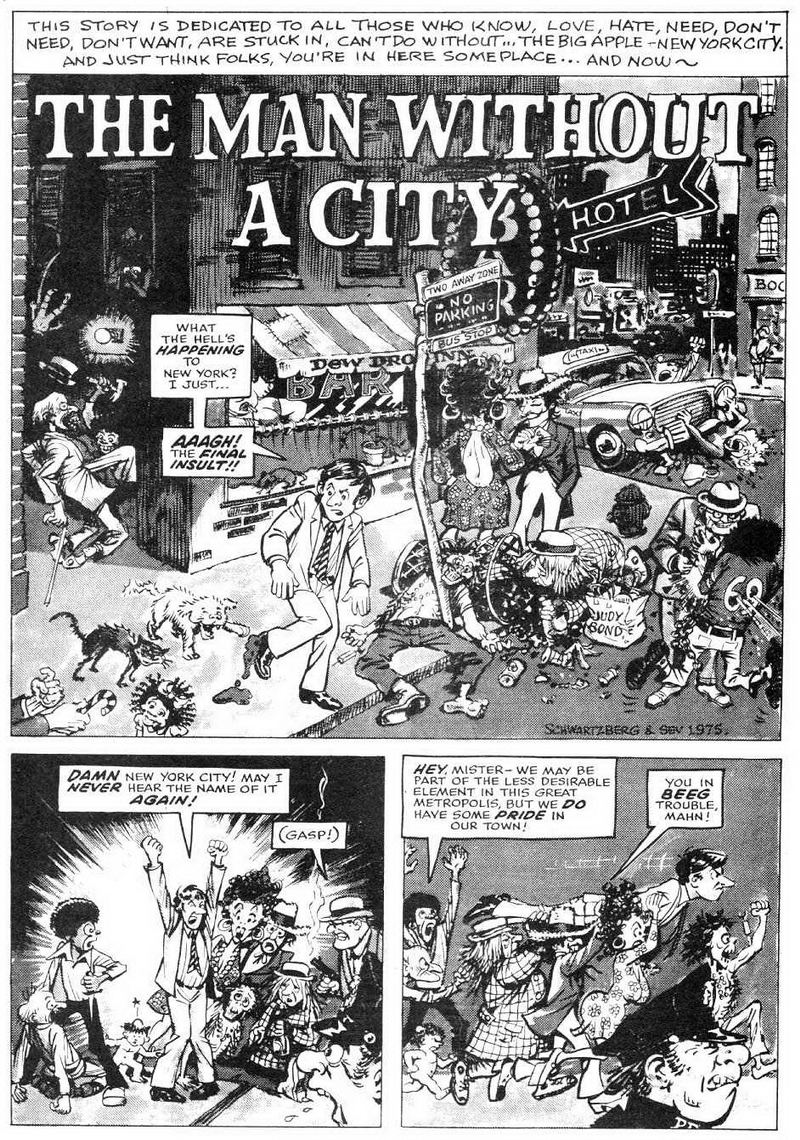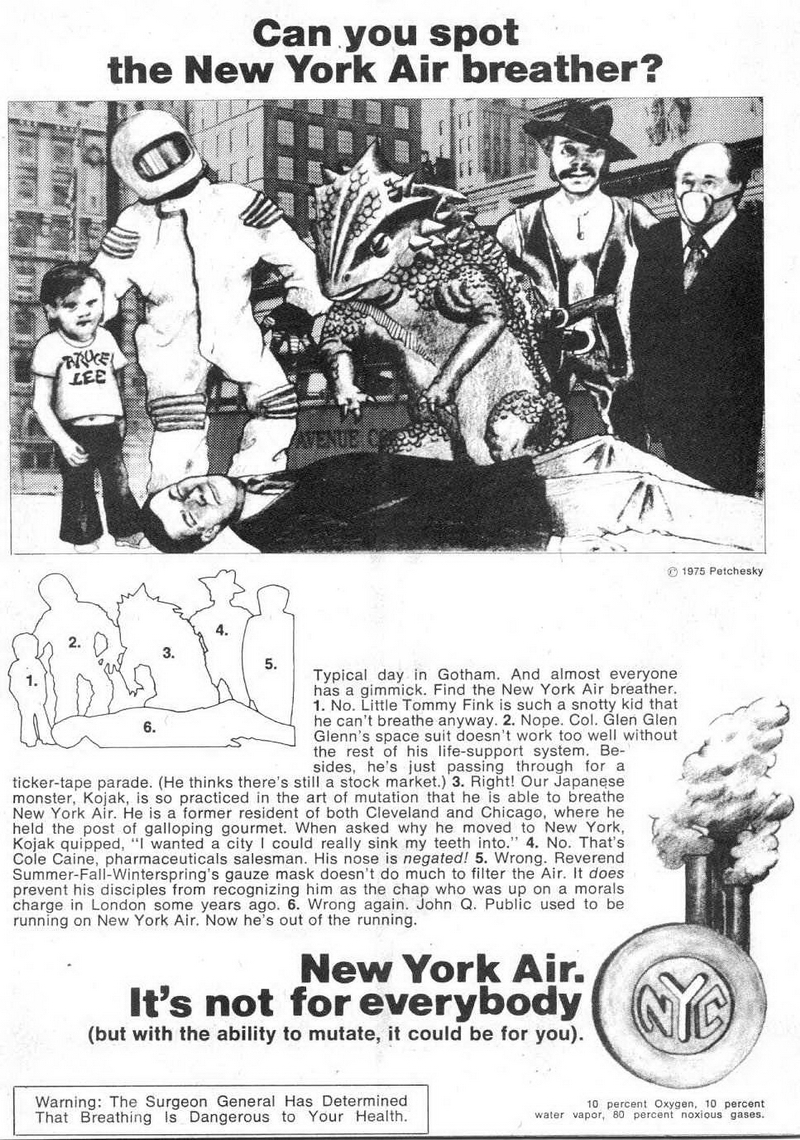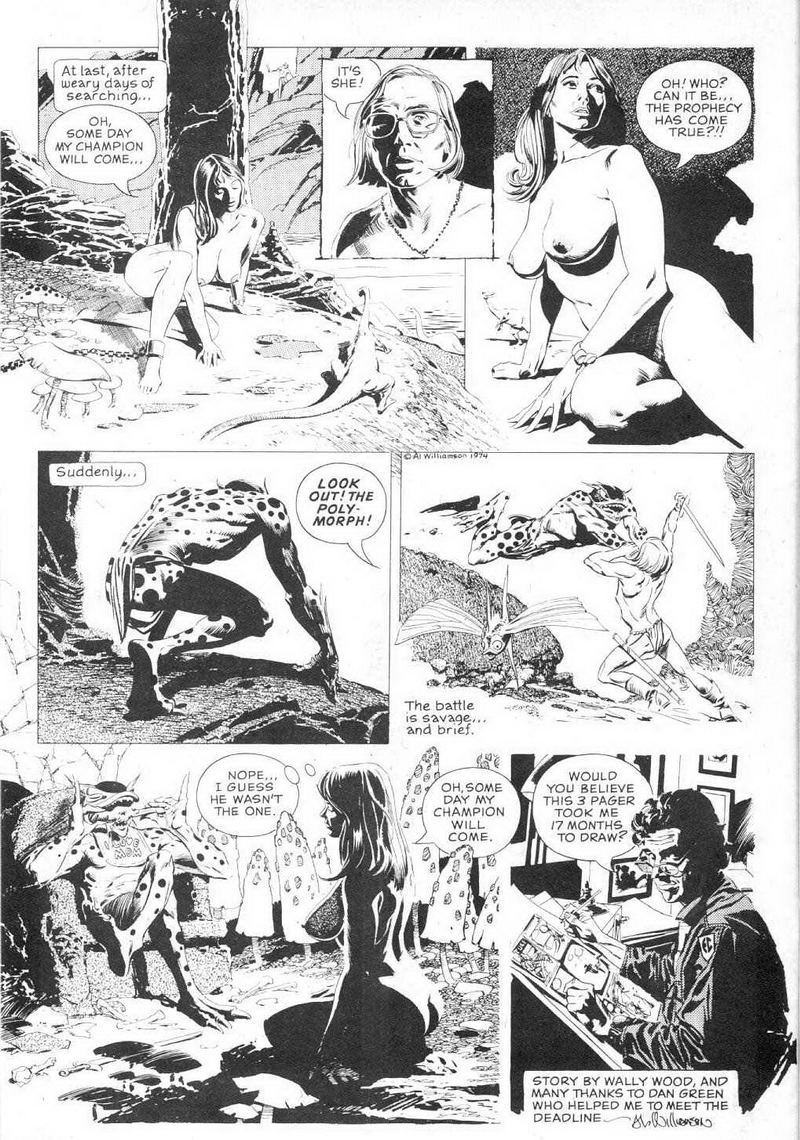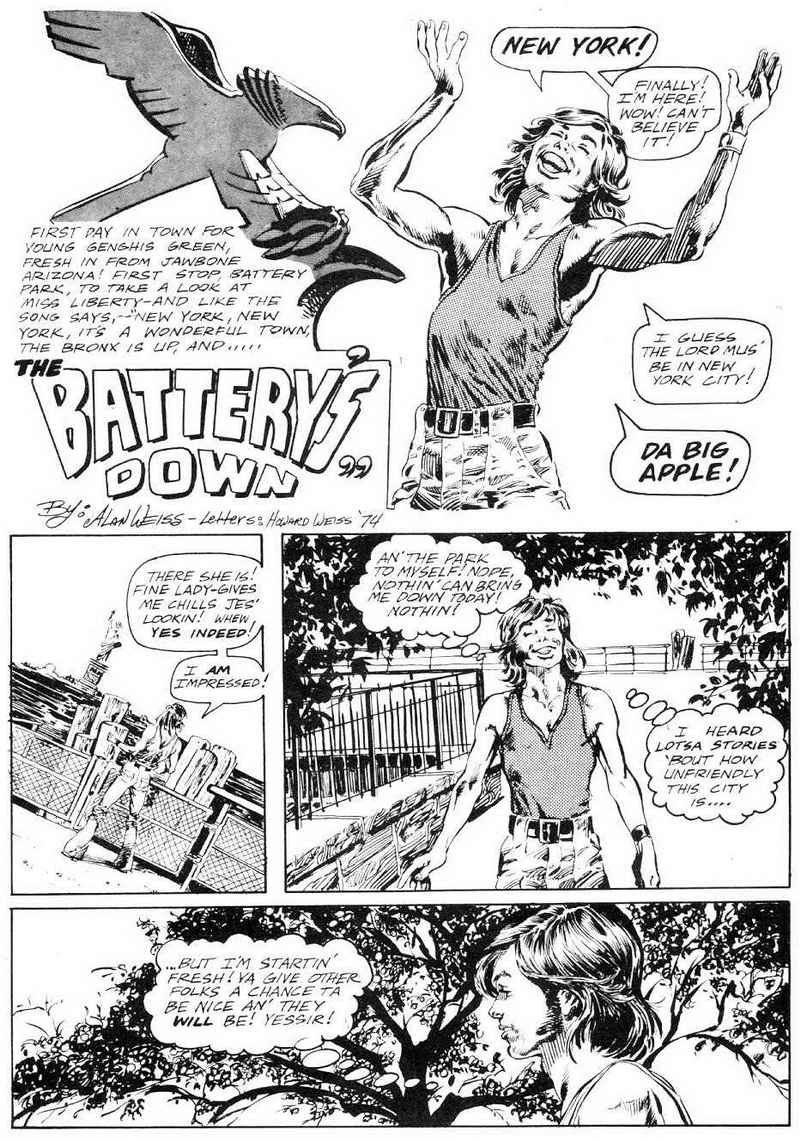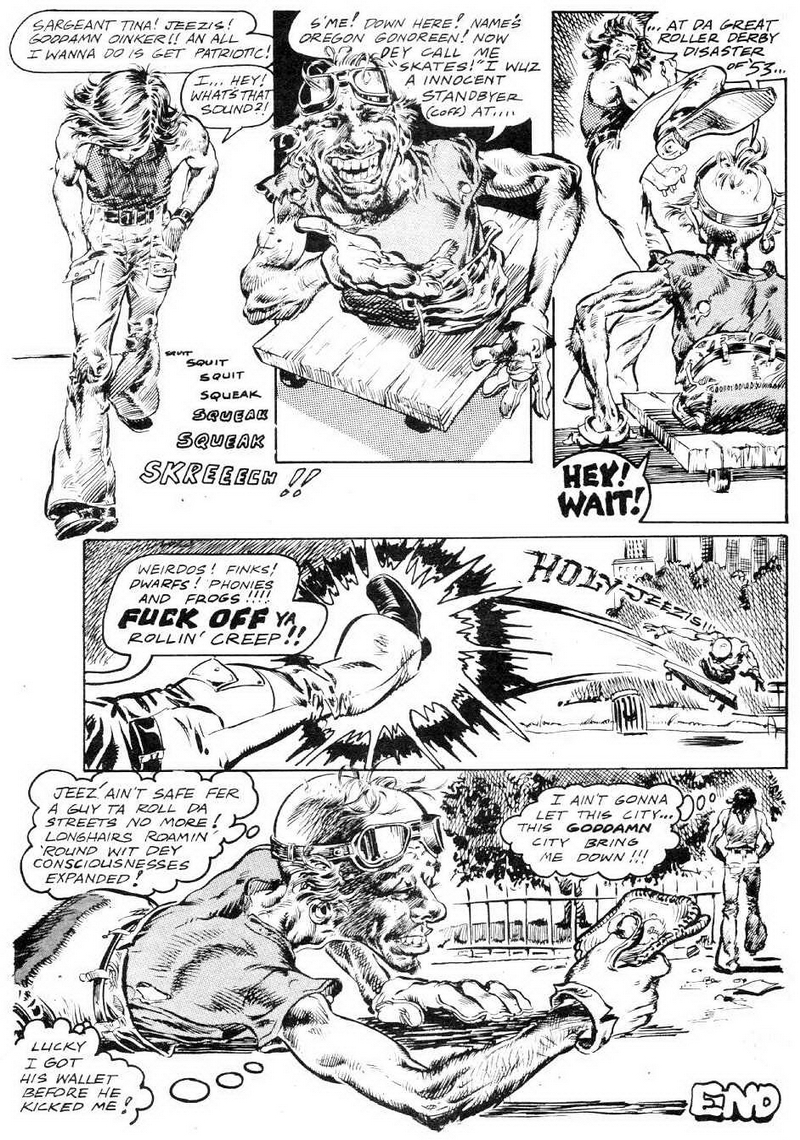big apple comics

big apple comics
Big Apple Productions September 1975
Big Apple Comix is a terrific comic book that is classified by some historians as a “link between underground comix and alternative comics.” I can understand that classification, since the contributors are mainstream (Marvel, DC and Warren) comic creators with no tradition in underground comics and the publisher had no history of producing undergrounds.
But similar historical links between underground and alternative comics, like Star*Reach and High Adventure, include only mildly risqué content. Big Apple Comix, on the other hand, features portrayals of masturbation, fucking, strung-out whores and vomiting bums. Which doesn’t mean Big Apple doesn’t represent a transition from underground to alternative, but it’s a distinctly underground example of that evolution.
Big Apple Comix was published by Big Apple Productions, which was little more than a pseudonym for Flo Steinberg, who began as Stan Lee’s receptionist at Marvel Comics in the mid ’60s and evolved into an industry pioneer. In 1968, Steinberg discovered underground comics when she met Trina Robbins, who came to Marvel’s offices to interview Lee for the L.A. Free Press. Through Robbins, Steinberg met East Village Other cartoonists like Kim Deitch, Spain Rodriguez and Art Spiegelman.
Steinberg left Marvel in 1968 when Martin Goodman (Marvel’s founder and publisher) refused to give her a $5-a-week raise. In the early ’70s she moved to San Francisco and rubbed elbows with both feminist and underground comic creators before moving back to New York (after a brief respite in Oregon) to help Warren Publishing with their mail order division. By 1974, Steinberg was an established industry insider and Big Apple Comix was in the planning stages.
Leveraging her extensive connections with mainstream comic creators, Steinberg lined up legends like Neal Adams, Archie Goodwin and Al Williamson to contribute to her book about life in New York City. She offered all of them the same freedoms she’d seen in underground comics. Some had enjoyed limited freedom when contributing to Warren magazines like Vampirella, Eerie and Creepy, but they took it to the next level for Big Apple, crafting sordid, sexually graphic storylines.
Some of the book is as mild as any Mad magazine, but the more vulgar content would keep Big Apple Comix out of most retail outlets. And since the underground comic distribution system of head shops had virtually disintegrated by 1975, Steinberg leveraged her experience at Captain Company, the mail-order division of Warren Publishing, to sell most copies of Big Apple through mail order.
There are multiple highlights in the book for underground comic fans, beginning with Archie Goodwin’s “Peep Shows,” which demonstrates the difference between “sleezy” peep shows and “klassy” peep shows. While not as bawdy as something that Crumb or Williamson would’ve done, “Peep Shows” offers readers insight into what porn aficionados had to go through back in the day (before all the free porn on the Internet)!
Perhaps the best story in Big Apple is “Over & Under” by Larry Hama and Neal Adams, which features dual stories about a street whore and a Madison-Avenue corporate secretary. Each page of the story is vertically split, with Adams’ chronicle of the secretary on the left side and Hama’s tale of the slut on the right. The authors show how both women use sex for monetary gain, demonstrating how subjective perception can be in the war of the sexes.
The most historically important story in Big Apple is Wallace Wood’s “My Word”; an exquisitely furious parody of Al Feldstein’s “My World” that Wood illustrated for the final issue of EC’s Weird Science back in 1953. “My World” was Feldstein’s reverent tribute to Wood, a brilliant 26-year-old comic illustrator at the time, guiding the reader through the amazing fantasy world that Wood painstakingly crafted in one comic book story after another. Feldstein’s script describes Wood’s surrogate life in EC comic books during the early ’50s; “My world is what I choose to make it. My world is yesterday…or today…or tomorrow…for my world is the world of science fiction…conceived in my mind and placed upon paper with pencil and ink and brush and sweat and a great deal of love for my world.”
More than two decades later, Wood was a chronic alcoholic, beaten down and chewed up by the industry he had devoted “his world” to. In “My Word” Wood unleashes a diatribe about life in the execrable concrete jungle of New York and, most critically, life as an underpaid, overworked comic book legend: “That mysterious process by which one’s fantasies enrich the lives of others…and the pockets of publishers. But it is worth it, for there are the fans.” The fans are represented by a naked boy groveling on the floor, bleating, “Do what you want with me! Kick me! Fuck me! Shit on me! I love you! By the way, your old stuff was better…” Two-faced parasite fuckers, the fans.
The last page of “My Word” accelerates Wood’s caustic rhetoric, saying “you must love yourself before you can love anyone else, but how many people really can?” while showing a young woman and man hunched over, giving themselves oral sex. Wood equates the written word with oral pacifications, both carnal and chemical, before literally flipping off the reader and depicting his own grave with a “final farewell message to the entire human race” carved into his tombstone: “Okay, do me something now, you cock suckers!”
Wood closes “My Word” with a final panel that mocks the one that closed “My World”: A cigarette-puffing, bug-eyed alien at the drawing board, declaring, “My word is the word I choose to make it, for I conceive it in my mind and put it down on paper with a lot of sweat and love and shit like that, for I am a troglodyte. My name is spafon gool.” For those out of the loop, spa fon is a nonsense word typically used by otherworldly beings to express shock or surprise in EC Comics stories. Wood replaced his own persona in the original story with a grim image of a sad and lonely alien, virtually imprisoned by his life’s work.
For fans of Wallace Wood, and there are many in the realm of underground comics (both collectors and creators), “My Word” reveals the bitter reality that Wood endured through the last 15 to 20 years of his life. Six years after producing “My Word,” after suffering kidney failure and a stroke that caused the loss of sight in one eye, Wood took a gun and blew his brains out. He was 54 years old.
Big Apple Comix is bit dated in spots (peep shows having gone the way of the typewriter) and the stories are fixated on one city, but the themes in this comic should resonate throughout urban America. The writing is pretty sharp and the artwork exceptional; a testament to the creators’ affectionate relationship with Flo Steinberg and their willingness to put their heart into stories that excoriate the ugly veneer of New York to show the vital spirit of the city.
Flo Steinberg (editor) – 35 • Stu Schwartzberg – 1+, 3-5+ • Larry Hama – 1+, 16-20+ • Paul Kirchner – 1+, 21 • Wallace Wood – 1+, 8-10, 27-28(i) • Michele Brand – 1(c), 2, 36(c) • Denny O’Neil – 2(e) • Sev – 3-5+ • Archie Goodwin? – 6-7 • Petchesky – 11 • Al Williamson – 12-14 • Linda Fite (production manager) – 15 • Ralph Reece – 16-20+, 36 • Neal Adams – 16-20+ • Herb Trimpe – 27-28(s,p), 31-34 • Mike Ploog – 29-30 • Alan Weiss – 22-26 • Howard Weiss – 22-26(l) • John Verpoorten (production)
2 – Foreword • 3 – The Man Without A City • 6 – Peep Shows • 8 – My Word • 12 – The Tube • 15 – A Nice Place To Visit, but… • 16 – Over & Under • 21 – New York City: The Future • 22 – The Battery’s Down • 27 – Lotsa Yox • 29 – The Silent Minority • 31 – Token • 35 – Backword • 36 – Hi There! I’m Paranoia!



